You are using an out of date browser. It may not display this or other websites correctly.
You should upgrade or use an alternative browser.
You should upgrade or use an alternative browser.
ALL THINGS TRANSFORMERS!!!!
- Thread starter p!tu
- Start date

Help Support Collector Freaks Forum:
This site may earn a commission from merchant affiliate
links, including eBay, Amazon, and others.
lerath666
Super Freak
Chinese import Legends devastator with Balls review
https://www.youtube.com/watch?v=x8v3Ub45_cY&feature=player_embedded
https://www.youtube.com/watch?v=x8v3Ub45_cY&feature=player_embedded
The ill Jedi
ILLest of 'em all!!
I have a few diamond select mimi-busts scheduled to arrive today. Jetfire, Megatron and Starscream. I still need to find Thundercracker and Skywarp at a resonable price. Finally got my Soundwave with Laserbeak. I pre-ordered Sunstorm.
Excellent pick ups Kit and Lenoir!!I have waited for so long, (for a good deal) and finally I have acquired my "grail"... the best, choice, pick, upper crust, "prime" of a toy ever MP-04 is mine!!!
Sorry I'm stoked!!!



I'm gettin' that Blaster fo' sho'!!SDCC exclusive is a Blaster reissue!

Reinhardt
Super Freak
Chinese import Legends devastator with Balls review
https://www.youtube.com/watch?v=x8v3Ub45_cY&feature=player_embedded
That was hilarious!
lerath666
Super Freak
gglad you liked it, from what I have heard, he has several parody reviews like this.
Reinhardt
Super Freak
I'll have to check it out. I have to admit, at first I thought he was just some massive Transformer geek until he unveiled the "Michael Bay" edition.

$14.99
DC Comics, 12-Inch Superman Action Figure, Collectible Kids Toys for Boys and Girls
Bopster USA Inc
lerath666
Super Freak
what, the notebook paper " 4th alt mode i paid 200$ for" did not tip you off?
heh.
my favorite part was the "rub his balls and he smiles" action feature
heh.
my favorite part was the "rub his balls and he smiles" action feature
Reinhardt
Super Freak
you know, i saw that, and saw the spelling mistake on childish writing, and I had to do a double-take - I wasn't sure if it was real or not!
frenzy_rumble
Freaked Out
- Joined
- Dec 7, 2009
- Messages
- 228
- Reaction score
- 0
I got these guys yesterday and thanks to a night with poor sleep, woke up extra early and painted them up...properly I guess you can say. I used a mix of the G1 cartoon images and my own spin on the color scheme. They are great little guys, tons of articulation, and about 1.75" tall (my eyes still hurt from the tiny details)
Since these are sort of a "self portait" and the fact they are my creation, I'm taking the liberty of calling the blue guy by his rightful name : Rumble.
More photos can also be seen here:
https://www.flickr.com/photos/accardi1/sets/72157623454689680/
Alt mode will be later this week.
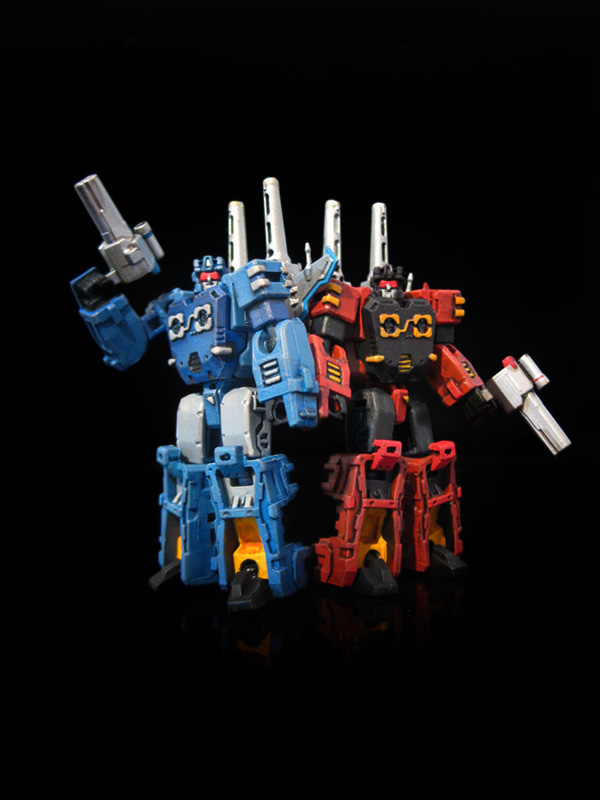
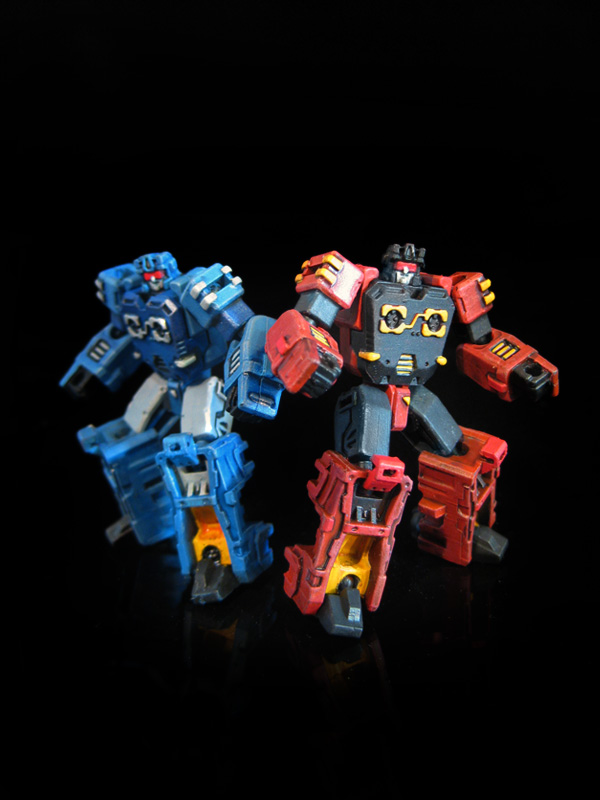
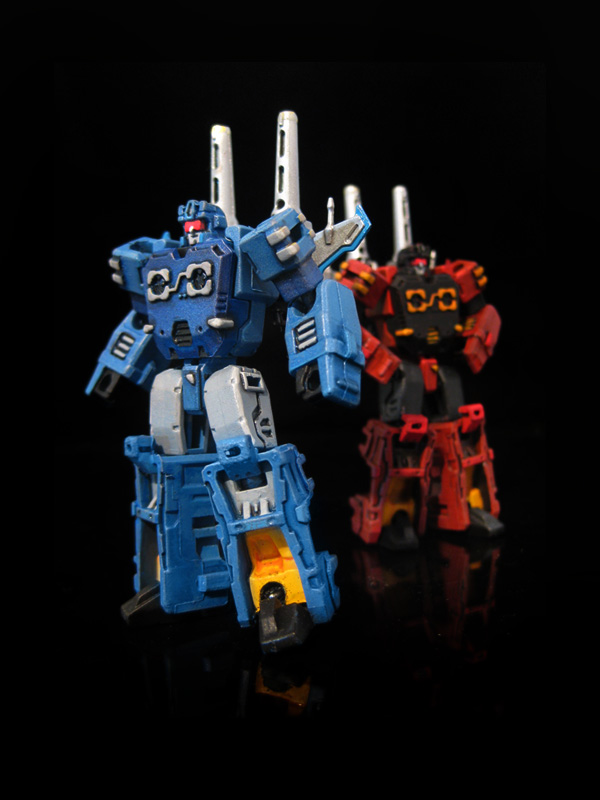

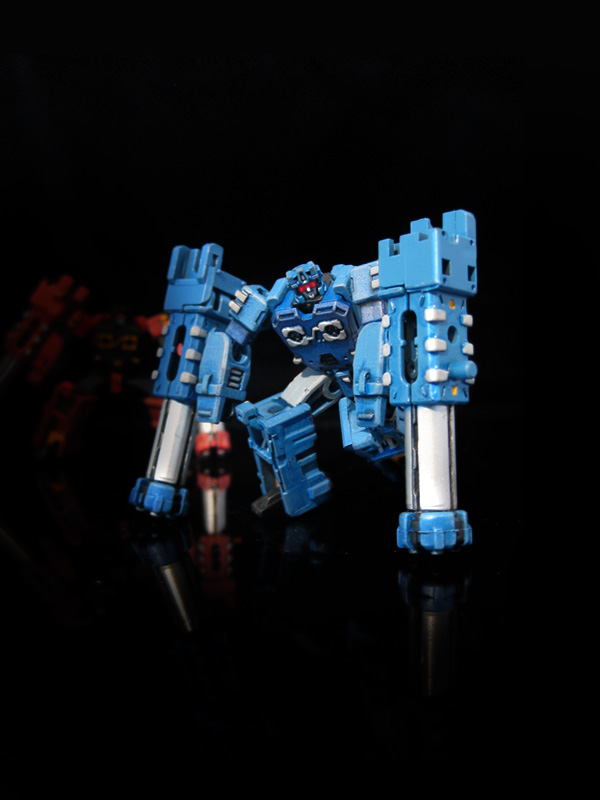
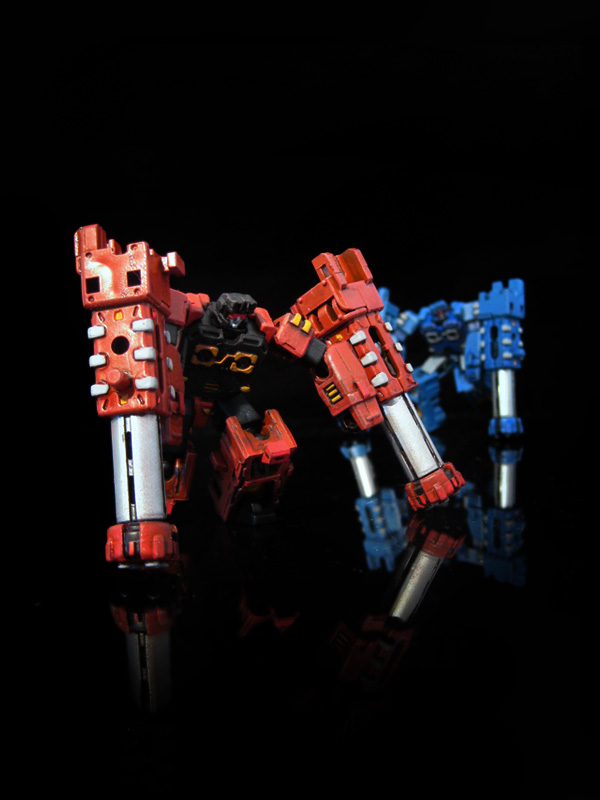
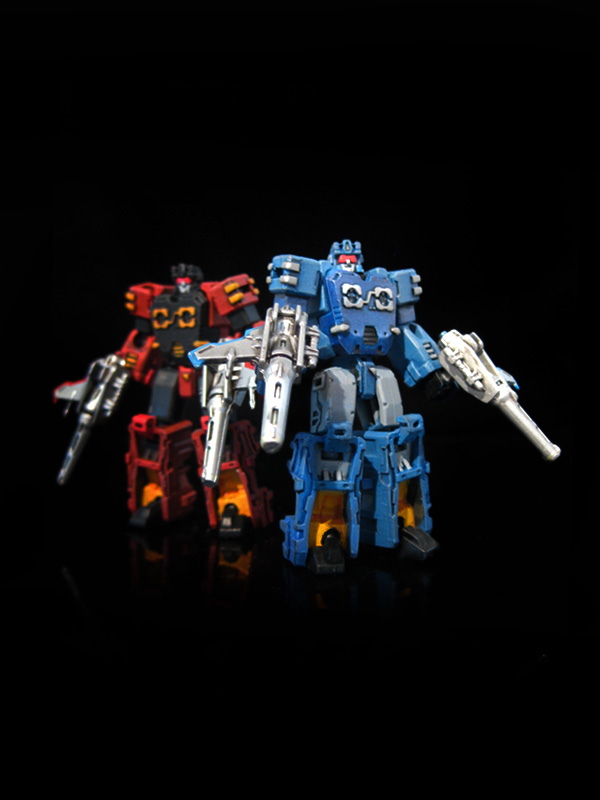
Since these are sort of a "self portait" and the fact they are my creation, I'm taking the liberty of calling the blue guy by his rightful name : Rumble.
More photos can also be seen here:
https://www.flickr.com/photos/accardi1/sets/72157623454689680/
Alt mode will be later this week.







lerath666
Super Freak
Nice job man, i'm on the fence about getting one of those myself, since their alt mode is a gun for shadow commander...
gotta find the shadow commander set first. overall, how sturdy to they feel?
gotta find the shadow commander set first. overall, how sturdy to they feel?
The Craw
Super Freak
so how big are the pile drivers? i wonder if i could mod them to fit on the vintage G1 version.
Chrakalackis
Super Freak
As it's been stated before (maybe not here, but on other forums) you really have to watch out for the chrome on MP Prime. I already have a chip on the grill after only a week, which I'm not at all happy about. 
I know the MP-04 is getting bad rep for QC, but from what I've read elsewhere the MP-01 and 20th also have chrome chipping and even "rub off" from handling. This is exactly why I've picked up a DVD Edition 20th just to have and display and I'll now put my MP-04 up for safe keeping.
Matter of fact I really don't see what the big deal is about the DVD one, now that I have it in hand it's a great "Masterpiece" even without all the chrome... just my two cents.
I know the MP-04 is getting bad rep for QC, but from what I've read elsewhere the MP-01 and 20th also have chrome chipping and even "rub off" from handling. This is exactly why I've picked up a DVD Edition 20th just to have and display and I'll now put my MP-04 up for safe keeping.
Matter of fact I really don't see what the big deal is about the DVD one, now that I have it in hand it's a great "Masterpiece" even without all the chrome... just my two cents.
Ra88
Super Freak
Very cool interview with one of Takara's designers, on how the TFA toys came to be.
https://www.tfw2005.com/boards/transformers-news-rumors/292394-takaratomy-staff-interview-animated.html
We wanted Transformers with strong individuality - Shogo Hasui
"Creating Distinctive Characters"
- Firstly, please tell us the development process of "Animated" project.
Hasui: The project itself launched long time ago, earlier than the Hollywood movie. It was 2005, and the series was meant to be a successor of "Galaxy Force (Cybertron)" cartoon series. At that time there was already a talk of a live action movie, but we did not know when it would actually go on production. Though soon after it was decided that the movie was to be released in 2007 and we suspended "Animated" project and concentrated on the development of the movie products.
We went back to "Animated" project in October 2006 and that was when we actually started working on the products.
- How did you decide on the American comic styled design, which is very different from the movie?
Hasui: The concept sketch we received from Hasbro showed Transformers that were not quite like the ones we were accustomed to up until "Galaxy Force". They looked more like suited-up American heroes than robots comprised of straight lines. I soon realized that the focus was on their characters as American action figures, not as transforming robot toys. When my superior asked me if I could pull it off, I answered, "I doubt if I could, I can't really find any vehicle parts that could turn into the robot body." But at the same time I felt enthusiastic about the challenge of creating a new design concept and transformation that would be different from "Galaxy Force".
Eventually I reached a conclusion that we needed to create robots whose proportions would imply what type of characters they were. What I did differently from "Galaxy Force" was to change the distribution of vehicle parts (in robot mode); I attempted to treat those parts as if they were muscles. For example, I designed a powerful looking character to have many of those parts on his arms to convey the impression of big muscular arms. I received applause like never before when I went with this idea and presented test models to Hasbro. It gave me confidence to continue on.
- What is the main focus of this series?
Hasui: As was evident in Hasbro's initial concept sketch, our aim in this series was to create Transformers with lots of unique individuality.
To achieve it, we put emphasis on the "silhouette"; the character's personality was to be clear just by a glance at their outline. For example, Ironhide (Bulkhead)'s massive arms indicate that he is powerful, while his round shouldered and chubby shape tells you he also has a gentle soul. We tried to show something about the characters with their body proportions.
At an early stage of development, Ratchet had a flatter stomach, until I noticed he was bigger in the concept sketch. I thought that might be his middle-aged bulge and added more bulk there. (*laugh) It also helped making his outline more distinctive.
There was also "stance", the way the character would stand. Optimus was designed with a certain "stance" in mind; he stands tall as if he is saying, "I am the leader!", which is typical of American heroes. Also, please take a look at their backs. All figures have very "expressive" backs. It is a common method when designing transforming robots to place excess parts on their backs, but we avoided it with this series. On the contrary, you can actually get an impression that they have backbones. The "stance" I have just talked about needs to emphasize a backbone, and a good balance can be achieved when the backbone looks slightly arched when viewed from the side, and with that they look great from any angle.
Also, we eliminated excessive details and used the surface of the vehicle mode parts to express the bulk of the robot. It made each character easily recognizable. Until "Animated", we always tried to have some standards for the vehicle and robot size, but this time we allowed more variety according to their characters. It was also the first time we attempted to add the characters' background to the toys, such as Ratchet's broken crest or joint to attach Lockdown's weapon. With this series the storyline was recongized at the development stage.
"Characteristic Transformation"
- What was the reason for the G1 homages?
Hasui: That was the cartoon company's choice. We normally prefer to create new characters with new styles. When I first heard their requests, I was impressed how much they loved (G1). Actually, Hot Rod was to be the main character initially. Bumblebee having speed as his attribute is a remainder of him.
The very first prototypes; "Hot Rod" and "Rhinox"
- What was the process of designing characters?
Hasui: Mr. Eric Siebenaler, a designer from Hasbro, and I worked together; I made some suggestions, and he always replied with encouragement and his own ideas. Hasbro and we had not communicated like this during a development of Transformers before. It was more of a one-way correspondence from each end to pick better ideas. But with "Animated", Hasbro and we exchanged our ideas, and I believe our discussion resulted in higher-quality products.
The character designs in Season 1 were decided after numerous changes during the discussions among the 3 companies (cartoon company, Hasbro and TakaraTomy). Actually, the first concept model was Hot Rod, and there were many alterations until he eventually became Bumblebee.
As for the Season 2 characters, because of the Movie product development preceding the cartoon, we received the designs which cartoon company and Hasbro decided on. Though I hear Eric-san negotiated the design adjustment with the cartoon company when the designs were impossible to contrive transformation.
- Are there any common gimmicks like the Movie lines' "Auto-Morph" or "Mech-Alive"?
Hasui: At a glance, they all seem to have different kind of gimmicks, but the common theme is to emphasize each character's personality.
For the early line-up, we introduced "Signature Transform". For example, Optimus' upper body rotates during transformation and Ratchet is posed as if he is ready to begin a repair operation when he is transformed. Also, the first figure I took on, Cybertron Mode Optimus, completes his transformation with a swing of the axe from the back. The concept was to give them personalized transformation which was not a mere "process" but a "play".
For later line-ups, we introduced "Signature Weapon" concept, such as Grimlock's flame sword and Soundwave's guitar. We actively proposed our ideas to be added to the character set up sent from Hasbro. Soundwave didn't have a weapon at first, but I felt he needed a musical themed weapon to make himself more appealing. I suggested a familiar spirit that transforms into a guitar for him, and the suggestion was accepted!
- There must have been a time you that you were working on "Classics", "Animated" and "The Movie" in parallel?
Hasui: "Revenge (of The Fallen)" certainly overlapped (with "Animated") and I was drawing Sideswipe and Samurai Prowl at the same time. It was very hard to change the way of thinking to alternate between the two as there was a big difference in the numbers of the lines required for each designs. Though the basic order was "Animated" - "The Movie" and it helped me work with some consistency. I would have been more confused if the order was other way round. There was also technical synergy effect between the two series. We wouldn't have been able to create characters with such unique appearance for "Revenge" if not for the know-how we gained from "Animated". It has of course been reflected on the improvement of the products as merchandise.
By the way, I used to use a ruler when drawing straight lines up until "Galaxy Force", but now I draw without one. I add slight curves to straight lines and try to avoid using parallel lines in order to create the impression of musculature.
"Transformers as a Family Entertainment"
- Tell us about your first impression of "Animated" visuals.
Hasui: The first image I saw was a line drawing of Optimus transforming. His movement was like a tornado and I adopted it to his transformation gimmick. The animation was very expressive and even though I didn't fully understand the language it was still very enjoyable. The show is definitely a pure entertainment that can be enjoyed by everyone. We had been hoping for a while to make Transformers series more family oriented, and "Animated" is certainly heading that way. Also, you don't see the characters holding firearms in the cartoon, it is because the show is intended for the whole family. The decision has been reflected on the toys as well, and even when the character is armed, the weapon is designed not to be realistic or he does not hold it like a gun.
- Tell us about the latest tendency on the development side?
Hasui: When I joined the company (in 1999), we might use the traditional Transformers names, but the characteristics for them were not the same. But recently I have noticed the design and personality are more set according to the character such as Optimus or Bumblebee.
Back in the days of "Micron Legend (Armada)", it was merely my personal preference to give Starscream a "traditional Starscream" appearance, but the whole franchise tends to pay homage to the old characters lately. I am happy with it.
This new trend is very evident in "Animated" and "The Movie", Optimus is definitely the one who takes the lead while Bumblebee seems innocent and somewhat childlike.
- Lastly, please send your message to the fans.
Hasui: Transformers have always been adopting something new, and "Animated" has become a series with a new perspective like we have never had before thanks to its theme, "making individuality stand out". Everything about "Robot", "Vehicle" and "Transformation" is fresh and unique. While retaining the respect for the series up to now, we also added the new perspective and fun to the toys. This is evident once you actually handle them. Please try them, you will see how "Transformers" toy series are carrying on as they expand.
https://www.tfw2005.com/boards/transformers-news-rumors/292394-takaratomy-staff-interview-animated.html
bagelsncheesey
Super Freak
page 3? 

Very cool interview with one of Takara's designers, on how the TFA toys came to be.
https://www.tfw2005.com/boards/transformers-news-rumors/292394-takaratomy-staff-interview-animated.html
Intresting stuff,my own take on Animated is that the cartoon sucked balls but there were a few nice toys..........Leader Megatron & Deluxe Blurr are my favorites.
I've just ordered,
Alternity Bumblebee
Alternity Cliffjumper
Alternity Megatron ( silver )
I also want Convoy but the Vibrant Red version is proving hard to come by for a decent price.
Ra88
Super Freak
New trailer!
<div style="width: 480px;"><object classid="clsid:d27cdb6e-ae6d-11cf-96b8-444553540000" codebase="https://download.macromedia.com/pub/shockwave/cabs/flash/swflash.cab#version=8,0,0,0" id="gtembed" width="480" height="392"> <param name="allowScriptAccess" value="sameDomain" /> <param name="allowFullScreen" value="true" /> <param name="movie" value="https://www.gametrailers.com/remote_wrap.php?mid=62343"/><param name="quality" value="high" /> <embed src="https://www.gametrailers.com/remote_wrap.php?mid=62343" swLiveConnect="true" name="gtembed" align="middle" allowScriptAccess="sameDomain" allowFullScreen="true" quality="high" pluginspage="https://www.macromedia.com/go/getflashplayer" type="application/x-shockwave-flash" width="480" height="392"></embed> </object><div style="font-size: 10px; font-family: Verdana; text-align: center; width: 480px; padding-top: 2px; padding-bottom: 2px; background-color: black; height: 32px;"><div><a style="color:#FFFFFF;" href="https://www.gametrailers.com" title="GameTrailers.com">Video Games</a> | <a style="color:#FFFFFF;" href="https://www.gametrailers.com/game/transformers-war-for-cybertron/12451" title="Transformers: War for Cybertron">Transformers: War for Cybertron</a> | <a style="color:#FFFFFF;" href="https://www.gametrailers.com/video/exclusive-gameplay-transformers-war/62343" title="Exclusive Gameplay Reveal Trailer HD">Exclusive Gameplay Reveal Trailer HD</a></div><div style="padding-top: 3px;"><a style="color:#FFFFFF;" href="https://xbox360.gametrailers.com/" title="XBox 360">XBox 360</a> | <a style="color:#FFFFFF;" href="https://ps3.gametrailers.com/" title="PS3">Playstation 3</a> | <a style="color:#FFFFFF;" href="https://wii.gametrailers.com/" title="Wii">Nintendo Wii</a></div></div></div>
<div style="width: 480px;"><object classid="clsid:d27cdb6e-ae6d-11cf-96b8-444553540000" codebase="https://download.macromedia.com/pub/shockwave/cabs/flash/swflash.cab#version=8,0,0,0" id="gtembed" width="480" height="392"> <param name="allowScriptAccess" value="sameDomain" /> <param name="allowFullScreen" value="true" /> <param name="movie" value="https://www.gametrailers.com/remote_wrap.php?mid=62343"/><param name="quality" value="high" /> <embed src="https://www.gametrailers.com/remote_wrap.php?mid=62343" swLiveConnect="true" name="gtembed" align="middle" allowScriptAccess="sameDomain" allowFullScreen="true" quality="high" pluginspage="https://www.macromedia.com/go/getflashplayer" type="application/x-shockwave-flash" width="480" height="392"></embed> </object><div style="font-size: 10px; font-family: Verdana; text-align: center; width: 480px; padding-top: 2px; padding-bottom: 2px; background-color: black; height: 32px;"><div><a style="color:#FFFFFF;" href="https://www.gametrailers.com" title="GameTrailers.com">Video Games</a> | <a style="color:#FFFFFF;" href="https://www.gametrailers.com/game/transformers-war-for-cybertron/12451" title="Transformers: War for Cybertron">Transformers: War for Cybertron</a> | <a style="color:#FFFFFF;" href="https://www.gametrailers.com/video/exclusive-gameplay-transformers-war/62343" title="Exclusive Gameplay Reveal Trailer HD">Exclusive Gameplay Reveal Trailer HD</a></div><div style="padding-top: 3px;"><a style="color:#FFFFFF;" href="https://xbox360.gametrailers.com/" title="XBox 360">XBox 360</a> | <a style="color:#FFFFFF;" href="https://ps3.gametrailers.com/" title="PS3">Playstation 3</a> | <a style="color:#FFFFFF;" href="https://wii.gametrailers.com/" title="Wii">Nintendo Wii</a></div></div></div>
WFC is looking VERY promising, the visuals are way better than the movie games and hopefully the gameplay will have more depth to it as well................,I really,really want that Deluxe Bumblebee toy now!
bagelsncheesey
Super Freak
yup, can't wait for WFC. looks to be a great game, and an interesting storyline to fit into the TF Universe. 

Chrakalackis
Super Freak
I already have a chip on the grill after only a week, which I'm not at all happy about.
I would like to happily retract this statement as upon further inspection my "chip" was actually a smudge. I was all ready to do some repair touch up on him, and when I began to thoroughly clean the surface it rubbed off!!! Man I'm stoked!!!


Similar threads
- Replies
- 0
- Views
- 296
- Replies
- 3
- Views
- 1K
- Replies
- 2
- Views
- 2K
- Replies
- 4
- Views
- 1K
Latest posts
-
-
Kaustic Plastik / Infinite Statue 1/6 Frankenstein Luxury Action Figure
- Latest: Dr. Anton Phibes
-
-
-














